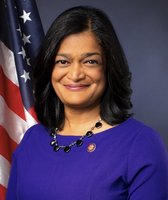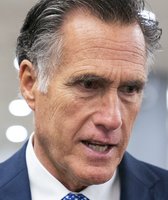Stand up for the facts!
Our only agenda is to publish the truth so you can be an informed participant in democracy.
We need your help.
I would like to contribute
A widely criticized immigrant investor program is back in the spotlight after the sister of Jared Kushner, President Donald Trump’s senior adviser and son-in-law, courted investors for a family real estate project.
Nicole Meyer, Kushner’s sister, earlier this month was in Beijing seeking $150 million from Chinese investors for Kushner Companies’ One Journal Square, a Jersey City housing development, according to media reports.
The Kushner business seeks to raise funds for the project through the EB-5 immigrant investor program, which allows wealthy foreigners to invest at least $500,000 in American projects and in turn, if conditions are met, get lawful permanent residence in the United States.
Critics say the program is a conduit for fraud and abuse.
Meyer told investors the Jersey City development "means a lot to me and my entire family," and that her brother served as chief executive of Kushner Companies before leaving the company to work for the president, the New York Times reported.
Sign up for PolitiFact texts
Meyer’s comments raised eyebrows about potential conflicts of interests surrounding the family business and Kushner’s role in the White House. Kushner Companies later issued an apology and said it was not Meyer’s intent to attract investment using her brother’s name.
Kushner Companies on May 11 told the Washington Post that neither Meyer or other employees would participate in upcoming scheduled investor presentations in China.
We wanted to examine the visa program created by Congress, which is often used by Chinese investors. The Trump administration says it supports program reforms in light of bipartisan criticism.
Congress established the EB-5 visa program in 1990 to attract foreign investment and create jobs in the United States. (The program gets its name from the employment-based visa granted to applicants.)
Initially, the only way for foreigners to invest was directly into new commercial enterprises. But Congress expanded investment options in 1992 by creating the Immigrant Investor Program (also referred to as the Regional Center Program).
The expansion allowed EB-5 investors to put their money in certain projects associated with regional centers approved by U.S. Citizenship and Immigration Services (USCIS), the agency that administers the EB-5 program. Regional centers allow multiple EB-5 and non-EB-5 investors to team up and pool their money into projects in specific geographic areas, said a Congressional Research Service report.
The regional centers program started as a pilot program and has continually been reauthorized. Most recently, Trump’s signing of Public Law 115-31 extended the program through Sept. 30, 2017 (the end of fiscal year 2017). The Department of Homeland Security is considering reforms to the visa program.
The number of EB-5 visas issued per year is capped at 10,000. About one-third of visas go to the investors; the rest go to the investors’ family members (spouses and unmarried children under 21 years old).
EB-5 investors and their family get conditional lawful permanent residence in the United States.
The conditional status is eventually removed if investors create or keep 10 permanent full-time jobs for U.S. workers, invest at least $1 million, or $500,000 if it is in a Targeted Employment Area (a rural area or an area with unemployment of at least 150 percent the national average rate).
In recent years, the majority of EB-5 visas have gone to mainland Chinese nationals.
Why?
The country has many millionaires, many of whom have amassed their fortunes through real estate ownership, said Gary Friedland, a scholar-in-residence at New York University Stern School of Business and an EB-5 expert who has testified about the program before the Senate Judiciary Committee.
Many investors come to the United States to further their children’s education, to give them an opportunity to work and live in the United States after they graduate, and to escape the high levels of pollution and poor air quality back home, Friedland continued.
China also has the most advanced network of migration agents promoting U.S. projects and soliciting investors, he said.
China experienced the greatest growth in EB-5 visas issued from fiscal years 2009 to 2014, according to an April 2016 Congressional Research Service report.
In 2009, individuals born in mainland China received about 2,000 EB-5 visas and status adjustments. That figure increased to slightly more than 9,000 in 2014, State Department data shows.
In fiscal year 2015, about 84 percent of the visas issued went to China, the CRS report said. Vietnam placed second, with approximately 3 percent.
The CRS report said that as of April 2016, the State Department was still processing visas for Chinese applicants who had their petitions approved in February 2014.
Republican and Democratic lawmakers have questioned the economic impact of the EB-5 program and have introduced bills seeking tighter controls and reform.
Critics claim the program has become subject to fraud and abuse and that the U.S. Citizenship and Immigration Services fails to provide information about the program’s effectiveness.
Immigration officials previously told PolitiFact it does not have data on the total number of jobs or financial investment created through EB-5. The immigration agency referred us to a sample, based on a Commerce Department analysis published January 2017. The report examined 562 active projects during fiscal years 2012 and 2013, expected to create about 174,000 jobs.
More than 11,000 immigrants invested nearly $5.8 billion in projects in that two-year period, according to the analysis. Investment on those projects from sources other than EB-5 was about $10.9 billion.
We recently rated Mostly True a claim from Democratic Vermont Sen. Patrick Leahy who said only a small number of wealthy foreigners invest in true high-unemployment areas, and that almost every other EB-5 project uses gerrymandering to qualify as distressed.
The White House told the New York Times that Trump endorses changes to the EB-5 program, and that Kushner’s work will not deal with that visa program.
The White House in a statement also said it "is evaluating wholesale reform of the EB-5 program to ensure that the program is used as intended and that investment is being spread to all areas of the country," the New York Times reported.
In a May 4 interview with The Economist, Trump said he wants talented people coming in who will not depend on any form of subsidies to live in the United States.
"I want people to come in legally. But I want people to come in on merit. I want to go to a merit-based system," Trump said.
Trump during the presidential campaign promised to reform legal immigration.
So far as president, he’s met with Republican senators who introduced a bill to reposition legal immigration toward employment-based preference and who seek to restrict the number of people who come in as family-sponsored immigrants.
Our Sources
CBS News, Jared Kushner's sister woos China's "golden visa" investors, May 7, 2017
The New York Times, Jared Kushner’s Sister Highlights Family Ties in Pitch to Chinese Investors, May 6, 2017
The New York Times, Kushner Companies Backs Out of Chinese Investor Events After Furor, May 12, 2017
The Washington Post, Changes to visa program could set back Kushner family’s real estate company, May 11, 2017
U.S. Citizenship and Immigration Services, EB-5 Immigrant Investor Program
U.S. Citizenship and Immigration Services, About the EB-5 Visa Classification, last updated May 11, 2017
Congressional Research Service, EB-5 Immigrant Investor Visa, April 22, 2016
State Department, Visa statistics, FY2009, FY2014
U.S. Department of Commerce, Estimating the Investment and Job Creation Impact of the EB-5 Program, January 2017
PolitiFact, Mostly True: Leahy claim on immigrant investment through EB-5 program, March 21, 2017
Email interview, Gary Friedland, scholar-in-residence at New York University Stern School of Business, May 11, 2017
PolitiFact, Trump-O-Meter: limit legal immigration
The Economist, Transcript: Interview with Donald Trump, May 11, 2017


 Politifact Rating:
Politifact Rating: 





































